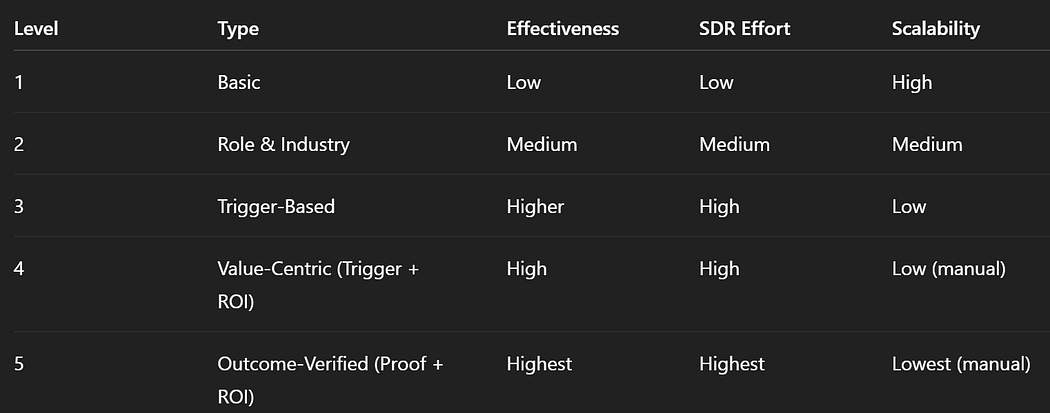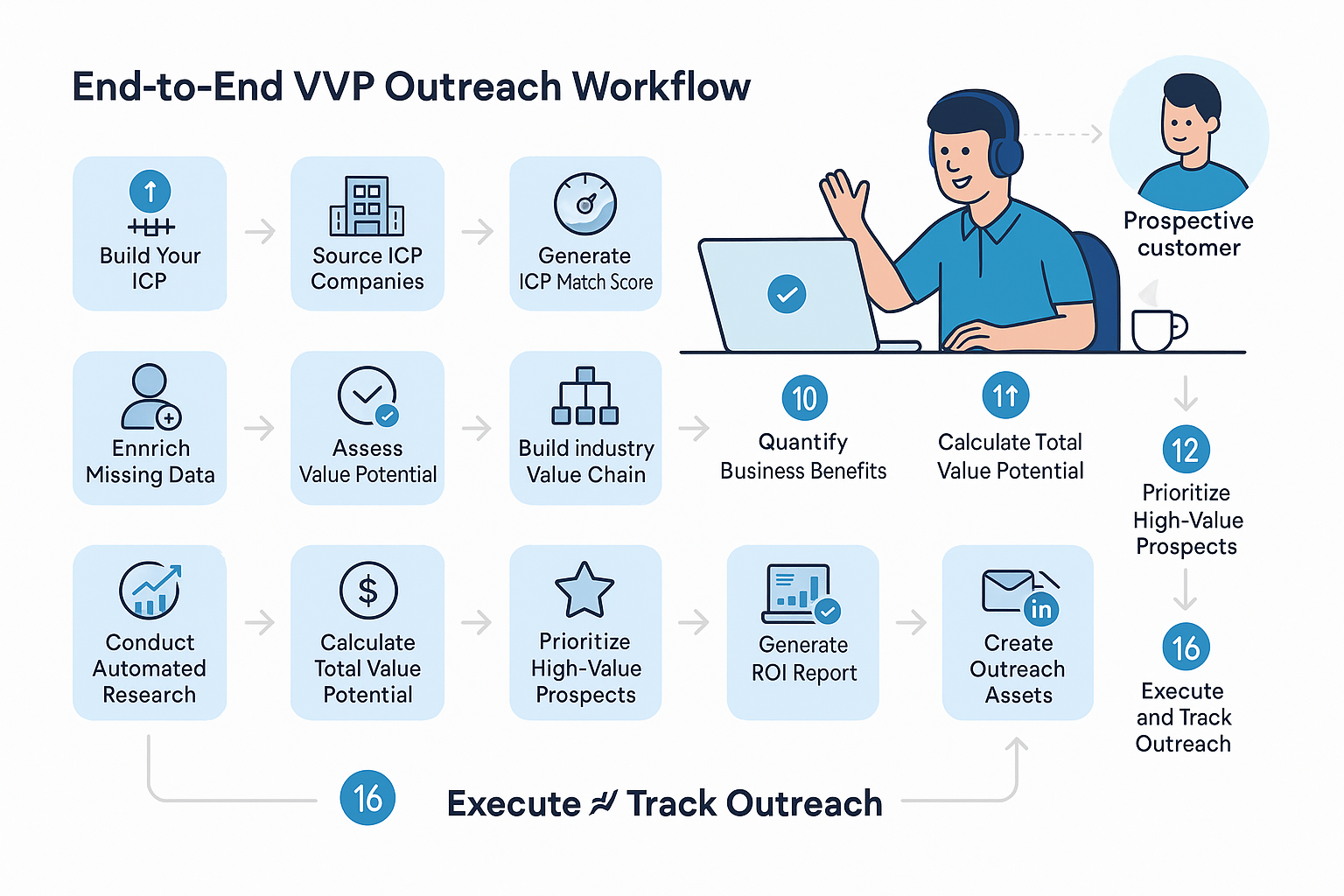Why Value-Centric Personalization Is the New Gold Standard in Tech Sales: And Why Only VVP Delivers It at Scale
If you’re still running outbound campaigns with generic templates and “Hi [First Name] - I saw your LinkedIn profile..." intros, you’re already behind.
In technology prospecting and sales, personalization is no longer a differentiator — it’s the minimum requirement. The companies winning today are those that can connect directly to a buyer’s priorities, quantify potential outcomes, and do it consistently at scale.
The reality? Most tools in the market can help you find leads or send messages — but none can help you create truly personalized, value‑centric, ROI‑driven personalization for every lead, every time.
That’s why ValueViewpoint.ai (VVP) is redefining sales personalization — enabling startups, mid‑size companies, and global enterprises to execute Level 5 personalization in every outreach without burning SDR hours on endless manual research. Below, we will dive deep into different personalization Levels and explain what Level 5 personalization means.
Where Personalization Changes the Game
- For Startups — Especially in the growth phase, VVP lets small teams act like enterprise sales orgs by instantly generating ROI-driven, personalized outreach for every prospect.
- For Mid‑Size Companies — It gives sales teams a scalable way to align SDRs, AEs, and VEs on one consistent, value‑centric message.
- For Enterprises — It operationalizes value selling across hundreds of reps, with full CRM integration, business case templates, and post‑sale value realization tracking.
Let's look at different types of personalization.
The Many Faces of Personalization in Technology Sales
In prospecting and sales outreach, “personalization” can mean very different things. Here’s the breakdown:
1. Basic Personalization
- What it is: Using a first name, company name, and an industry in a generic pitch.
- Example: “Hi Sarah, I thought [Company] might be interested in our AI solution for manufacturing.”
- Effectiveness: Low — 5–7% reply rates on average.
2. Role & Industry Personalization
- What it is: Tailoring messaging to the person’s job role and vertical.
- Example: “As a Head of IT in retail, you might be focused on lowering cloud costs and improving uptime.”
- Effectiveness: Moderate — 10–15% reply rates.
3. Trigger-Based Personalization
- What it is: Referencing a recent event or signal — funding round, job change, product launch — to make the message timely.
- Example: “Congrats on your Series B! Many CROs at your stage face longer sales cycles as teams scale.”
- Effectiveness: Higher — if paired with value.
4. Value-Centric Personalization
- What it is: Combining trigger + role + quantified business impact.
- Example: “With your new 20-person SDR team, VVP could cut ramp time by ~25%, unlocking $2.3M in additional ARR this year.”
- Effectiveness: High — 20–30%+ reply rates for Tier 1 accounts.
5. Outcome-Verified Personalization
- What it is: Using realized results from similar customers to establish credibility and trust.
- Example: “For [Similar Company], we increased pipeline conversion by 17% in 90 days, adding $1.8M in closed-won revenue.”
- Effectiveness: Highest — positions you as an advisor, not a vendor.
Different types of personalization require varying levels of skill, tools, and effort. In many cases, achieving higher levels of personalization can be highly time‑consuming and costly.
To understand these differences, let’s apply an Outreach State Assessment Framework using maturity levels.
- Level 1 demands minimal effort, skills, and tools.
- Level 5 is the most complex — often overlooked due to its difficulty — but also the most effective.
The Personalization Maturity Ladder
We can visualize this as a progression:

The challenge?
Most companies stall at Level 2 or 3 because moving to Level 4 or 5 requires deep research, ROI modeling, and case study access — all of which take time. SDRs simply don’t have the time.
ValueViewpoint.ai (VVP) is the only platform that automates Level 4 and Level 5 personalization for any size company:
How VVP Does It in Just 120 Seconds instead of hours or even days — Right From Your Favorite CRM
End-to-End VVP Outreach Workflow
1. Build Your ICP
Define your Ideal Customer Profile (ICP) — industry, company size, geography, tech stack, role, and other qualifying criteria.
2. Source ICP Companies
Use tools such as LinkedIn Sales Navigator, Lusha, Apollo, ZoomInfo, or PitchBook (depending on your organizational maturity and budget) to identify companies that fit your ICP.
3. Ensure Decision-Maker Coverage
Make sure each target company record includes key decision-makers.
4. Enrich Missing Data
If some contact data is missing, perform data enrichment through the same tools or manual research to ensure complete records. (This is often the most labor-intensive step without automation.)
5. Add Prospect to CRM
Enter selected prospects into the CRM as Company → Contact → Deal — but hold off on outreach until further validation.
6. Conduct Automated Research
VVP’s LLM runs market and prospect research automatically.
7. Generate ICP Match Score
The system assigns an ICP match score to each lead (still in MQL stage).
8. Assess Value Potential
Identifies the value potential for each MQL and ranks the highest-scoring ICP matches at the top for potential outreach — without personalization at this stage.
9. Build Industry Value Chain
Using the LLM engine, VVP builds a detailed customer industry value chain and maps key processes and metrics impacted by your product.
10. Map Product to Pain Points
Links your product attributes to specific pain points in the identified processes and metrics.
11. Quantify Business Benefits
Quantifies potential improvements as tangible business benefits — or pulls them from VVP’s AI-powered benefit library of similar use cases.
12. Calculate Total Value Potential
Calculates the total value the buyer could realize from your solution.
13. Prioritize High-Value Prospects
Selects only the highest ICP score and highest value potential prospects for outreach first.
14. Generate ROI Report
Instantly produces an executive-ready ROI report based on company size, process impact, and industry benchmarks.
15. Create Outreach Assets
Generates executive-ready outreach content — email copy, LinkedIn messages, and a 1‑page mini business case.
16. Execute and Track Outreach
- Send outreach directly from the CRM (e.g., from HubSpot deals, click the contact email to generate an email with a link to the 1‑pager ROI report).
- Track email opens, 1‑page report views, and ROI model entries in VVP without requiring registration.
- Track post-sale value to feed realized results back into future outreach, improving accuracy and credibility over time.
And this all happens directly inside your CRM in just 120 seconds. No other solution on the market can match this combination of Account-Based Marketing, Value Selling, and Outreach capabilities — three powerful tools in one — at the cost of a single platform.
Bottom Line
Personalization in tech sales is no longer about just “proving you did your homework.”
It’s about showing the prospect — in your very first touch — how you will create a measurable business impact for them.
That’s what VVP enables — at scale, across any market segment, for any sales team size.
And that’s why in the next wave of B2B sales, value‑centric personalization will separate the winners from everyone else.


